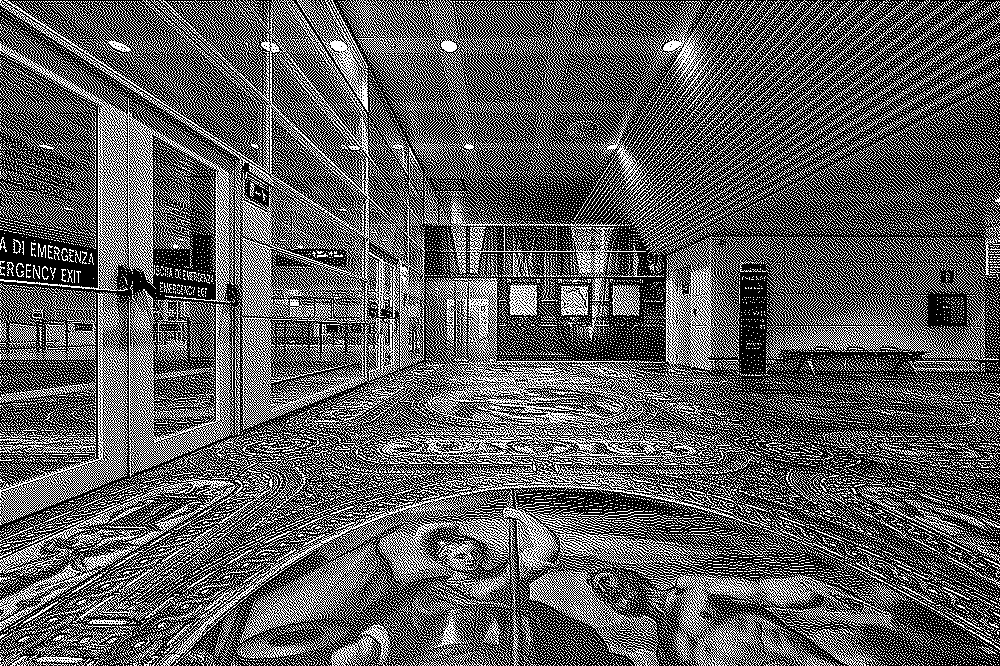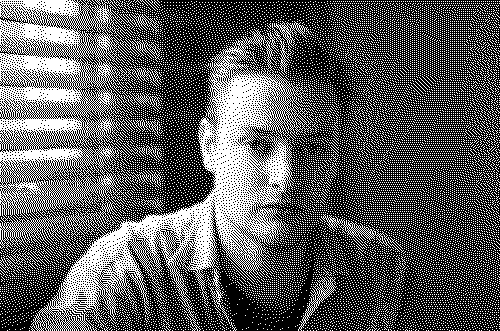Game of Two Halves
Simon Denny and the 56th Venice Biennale

Part I – The Marco Polo Airport
There is a family of stone goats in Auckland’s Myers Park. I attended the nearby Jewish school and remember seeing goat's horns in the Rabbi's office. To me, the horns appeared like something primeval (they were in fact, shofar, ceremonial horns to mark the end of Yom Kippur). Because of the goat's horns in the Rabbi's office, I'd assumed the goats in the park were Jewish. The goats seemed to be an authentic part of the area and were presumably rich in meaning to Arthur Myers, the Jewish philanthropist who gifted the land.
While on a recent trip to Europe to see family and 'big culture', I spent a few hours in Guangzhou Airport. Waiting for my transfer to Heathrow, I noticed a series of photoshopped murals depicting pre-industrial China, and prominent in each, my Jewish goats from Myers Park. It turns out that the goats were a gift to Auckland in the 1950s, to commemorate the naming of Guangzhou as our sister city (Auckland has 6 sister cities, and 2 friendship cities).
This anecdote might seem like a strange segue into Simon Denny's Secret Power, but to my mind, it caught the sense of mutable experience possible in a global age. Auckland and Guangzhou had perpetrated a bait and switch in much the same manner that Denny has conflated a library and an airport.
THE VIEW IS GRUBBY as you fly into Venice. Beneath the clouds is a petroleum complex made of steel and concrete. This oil refinery hidden at the top of the Aegean is the first impression of many visitors to the Venetian basin – a swamp renowned for its prettiness. Venice sinks under the weight of expectations.
I was grumpy as I got off the plane, and straight-away complained that Denny had placed part one of Secret Power in the arrivals terminal. In this hurried, jet-lagged space, Denny's captive audience is at their most irritable and unconscious, and far too busy being corralled like a bovine herd. On the inverse, those in the departure terminal tend to have an excess of time and plenty of vacant attention. Nevertheless - and despite the fact I only travel with a small carry-on bag - I made my way to Carousel #5 with aesthetic intentions.
Thanks to a near-constant stream of reviews and Denny profiles from media outlets like the Guardian, New York Times, and the Wall Street Journal, I felt pretty prepared for Denny's conceptual switcheroo. In fact, the work felt so familiar that visiting the exhibition felt cursory, a benign pilgrim to Denny, the 'New Zealand-born, Berlin-based artist' who had just climbed to 364 on the Artist Ranking Tool – an improvement of 182 on last year’s ranking.
Denny's carousel was revolving as I approached, and one part of the Titian fresco was spinning around the conveyor belt, providing a slapstick gimmick as it fell in and out of sync with the larger composition. It's a surprisingly simple conceit. Transplanting one architecture for another, Denny takes one of the City's least desired settings and injects an awkward nostalgia for Venice's historic centre. The vinyl Titians and Marciana posters are an anachronistic ode to Venice and a sage tribute to flawed authenticity.
Denny's plastic claddings – perhaps processed at the nearby oil refinery - ground the first instalment of Secret Power outside the timeless reverie given to Venice. The sinking city under constant maintenance - the Rialto Bridge restoration is brought to you by DIESEL – Venice has chosen to clad its construction sites in digitally rendered screens that recreate the hidden facades beneath. Even the timeless city is stamped with the imprint of global capitalism; its processes, its materials, and its ideologies. In the midst of these 'to-scale' corporate-sponsored mockeries, Secret Power reaches a logical conclusion. Titian on the carousel.
PART II – Biblioteca Marciana
THERE IS A LONG BRIDGE that connects Marco Polo Airport to Venice. Crossing the bridge on the airport shuttle bus, I could see the dome of Santa Maria and the tower of Saint Marco. Familiar sights, though not due to any art historical training (I got a C in 104 Renaissance Italy). Instead, I’d spent hours scaling Venetian rooftops in Assassin’s Creed II. This kind of knowledge that was once privileged, difficult to attain, can now be acquired in some surprising ways: for the price of the water bus up the Grand Canal, I’d already scaled 16th-century Venice and killed the Doge.
Walking off the wharf at Saint Marco, I noticed a Simon Denny banner draped over the big marble building to my left. I’d heard that it is hard to get noticed at the Venice Biennale. Well… noticing Denny was easy. It took gumption to hire the Biblioteca Marciana – I wonder what the weekly rental is for this 16th-century library?
Entering the Library, I was handed a brochure at reception and ascended to New Zealand’s national pavilion via the allegorical staircase of knowledge. The pomp continued as I surveyed the room housing Fra Mauro’s Map of the World, 1448-1453, which Wikipedia tells me is “a key memorial of medieval cartography”. The pavilion attendants (wearing Secret Power American Football jerseys) ushered me into the main hall of the Library, which houses work by Tintoretto, Titian, and New Zealand’s own, Simon Denny.
Composed of eight ‘server vitrines’, Secret Power (Marciana Edition) produces a portrait of the NSA through its former graphic designer David Darchicourt. Calling upon Darchicourt’s years of experience as an NSA ‘Creative Director’, Denny has created a sculptural record of the NSA’s image culture – as revealed by Snowden’s release of classified slides. It sounds complicated – and it is – though, the density of information and complexity of the narrative is precisely the rub. Navigating the vitrines and other display structures, it quickly becomes apparent that Denny isn’t pursuing a clear polemic; rather, his is a fetishist’s view of the usually politically rendered NSA.
Amongst gilded walls and renaissance frescos, Denny’s made-to-order structures were opulent in their own synthetic way. The vitrines felt sanitised: the interned sculptures vacuumed in a server farm’s banality. Glistening with LED light, Denny’s wunderkammern sneered and riled the Marciana’s tungsten interiors.
Upon a closer inspection of the vitrines, I realised I knew a lot more about Secret Power than I’d anticipated. Incessant references to WarhammerTM, Magic: The GatheringTM and Yu-Gi-OhTM represented a cultural milieu that I was surprised to share with the NSA’s tech-literate warriors. Denny had rendered a community of NSA analysts that probably weren’t on the high school football team.
The exhibition's reliance on gaming references describes a form of espionage born on the gaming table and tempered in the strategic training of role-play games. The US military establishment has long been wise to the indoctrinal potential of video games (releasing their first state-sponsored war game in 2002). Denny’s work draws a sage – albeit comic – relationship between the glamour of spies and espionage, and the much-maligned world of gaming.
Secret Power is not simply a sculptural report on the NSA: Denny’s matrix is also a form of satire. Within this sceptical comedy, New Zealand is the pip-squeak lackey of the ‘Five Eyes’ (an intelligence alliance comprised of the USA, United Kingdom, Canada, Australia, and yes, New Zealand). This absurdist lens is most clearly manifested in Darchicourt’s tuatara mascot, a reptilian android commissioned to represent the country.
Venice is strange, and Denny contributes another oddity to the city. The former maritime empire is a sage backdrop with which to consider America’s own hegemonic decline. Set amongst one of Europe’s great ‘civilising’ achievements, Denny expresses the less pleasant inward face of empire: control, surveillance, and paranoia.
PART III - Epilogue

VENICE IS STRANGE.
I looked across the canal to see the newest addition to the Biennale headquarters, the Australian Pavilion. The steel-clad structure loomed on the water’s edge like a dark modernist beast, and the iron ore surface left no illusions about where they’d got the money for the eleven-million dollar pavilion. Amidst plenty of pomp, Cate Blanchet cut the ribbon for the venue's inaugural exhibition. Accurately titled ‘Wrong Way Time’, Australia takes the prize for big money flop of the 56th Venice Biennale.
Perhaps strangest of all, the New Zealand representative at Venice has a German accent. In this fairground where nationalism is the binding oil, New Zealand backed a Berliner. Good call I reckon. The strongest pavilions at Venice are those that play with latent nationalism, and Simon Denny – with the assistance of investigative journalist Nicky Hager – cut against the usually conciliatory tone of Venice pavilions. Quantifying success in the arts might be a bit tricky, but Secret Power is as near to a consensus “smash hit” as the art world can provide.
In art’s professional era, Denny is the best on offer. Meticulously researched, impeccably presented, and extremely well-connected; Denny is a master of his craft. An arts equivalent to a Silicon Valley Executive, Denny’s latest Christie's video profile is a performance of product-orientated transcendence. It seems that Denny’s 2012 profile of the tech industry wasn’t simply an artistic conceit, but a statement of belonging.
Robert Leonard, the curator of Secret Power, offered up a provocative bit of hype in the build-up to Venice, describing Denny’s recent work as a “break-through moment”:
“I think of Manet’s Olympia, or Duchamp’s Fountain. Denny is doing something similar.”
While the comment belongs to the rhetoric of ascendance, I confess to having felt the same way about Denny during the 2014 Walter’s Prize. At the time I was working at the Auckland Art Gallery, convincing unsuspecting visitors to take a ride in Luke Willis Thompson’s taxi, and guarding the winding alleys of Denny’s DLD installation. It is very hard to maintain a gallery-minders interest over four months, but Denny’s group portrait of the Munich tech conference got under my skin. Dense and textual, and yet charged with immediacy, this was an artwork operating on uncommon terms. Denny’s installations can be read like road maps, guiding you to the correct, contextual understanding of the subject. The trail of fictitious memorabilia wants you to come along for the ride; it’s a guided tour without the docent.
While it may be fun to tease Denny about his German accent, let’s be mindful of the tall-poppy mentality lurking in our society. New Zealanders often conflate international success with abandonment, and smile, sure in the knowledge that like Billy Apple, they’ll be back, they always come back. Denny might one day come home and attend Parnell openings as an elder statesman, trading secrets of Berlin in the naughties for another glass of chardonnay. Perhaps snubbing Denny twice for the Walters Prize was our way of telling him that home can always make you feel like shit. I hope he gets nominated again, and again, until out of pure resignation Denny is sent the damn cheque.
2015-02-08